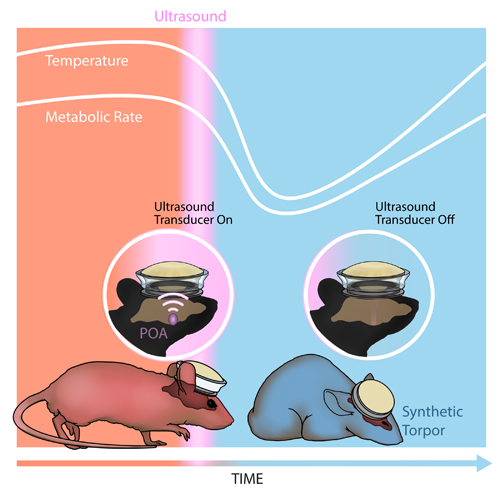A new strategy that brings a sci-fi staple closer to reality could buy time in critical care
Science fiction has long described sophisticated technology that can temporarily put humans into a suspended state, permitting characters to awaken far into the future, often after extended journeys through space. In reality, the basis for suspended animation could potentially rely on a far simpler technology — one used routinely in clinics for decades.
Researchers from Washington University in St. Louis have used ultrasound to nudge rodents into an energy-conserving state that mirrors a natural, hibernation-like survival mechanism known as torpor. In a new study published in Nature Metabolism, the team was able to lower the body temperature and metabolic rate of mice, and attain some of the same results in rats, which, like humans, do not naturally undergo torpor. While the technique may not be ready for interstellar travel just yet, it could be useful on a shorter horizon if it proves effective in humans, helping buy precious time for patients in critical care.

In the 1960s, near the dawn of the Space Age, scientists began searching for a biological trigger to artificially induce torpor or hibernation in humans. More recently, studies have hinted at a particular part of the brain, a region of the hypothalamus called the preoptic area, as the control system for such states.
“Other researchers have experimented with injecting chemicals into specific parts of the brain. We’ve taken a totally different approach with ultrasound, which can also modulate neural activity but is less invasive and generally inexpensive,” said senior author Hong Chen, Ph.D., an associate professor of biomedical engineering at Washington University in St. Louis.
Chen and her colleagues designed and fabricated wearable ultrasound probes that resemble circular caps and attached them to the animals’ heads. Then the team generated sound waves with the probes, aiming them at the hypothalamus.
They recorded the animals’ body temperature, heart rate, and oxygen consumption throughout the experiments. Within minutes of initiating the procedure in mice, the measurements for all three decreased. The researchers also noticed that the mice, though still awake, were far less physically active.
The authors of the study maintained the torpor-like state for just over 24 hours, after which they shut off the devices and the mice returned to their normal, active behavior without any lasting effects.
By examining mouse brain activity and tissue, they determined that the ultrasound procedure was activating neurons within the preoptic area. The authors also identified a likely mechanism for the ultrasound-induced torpor — a protein, also found in humans, that allows ions to flow into and activate these neurons.
Next, the team sought to prove that the strategy could work in non-torpic animals, a necessary step before evaluating the technology for human applications.
“After we finished the mouse studies, we tried to see whether we could use ultrasound to induce a similar state in rats, which, by nature don’t enter torpor or hibernation,” Chen said.
While the effects of ultrasound were less pronounced in rats than mice, the team still detected a considerable decrease in core body temperature. These results indicate that a torpor-like effect was induced by ultrasound in an animal that does not naturally enter torpor, a significant first, Chen said.
“It’s exciting to see this kind of significant neuromodulation performed with such a straightforward technology. It’ll be interesting to follow the development of this novel approach, which could one day have major implications for the clinic and beyond,” said Randy King, Ph.D., director of the ultrasound program in the Division of Applied Science and Technology at the National Institute of Biomedical Imaging and Bioengineering (NIBIB).
The team intends to continue developing their technique, adapting the technology for human anatomy.
If they prove its ability to induce torpor in people, then ultrasound could become a staple in treating patients who have experienced a stroke or heart attack. By slowing a patient’s metabolism, the method could minimize damage from these conditions, granting clinicians more time to identify and apply a remedy.
This research was funded by grants from NIBIB (R01EB027223, R01EB030102), the National Institute of Mental Health (R01MH116981, UG3MH126861), the Office of the Director at the National Institutes of Health (DP5OD028125) and the Burroughs Wellcome Fund (CAMS no. 1019648).
This Science Highlight describes a basic research finding. Basic research increases our understanding of human behavior and biology, which is foundational to advancing new and better ways to prevent, diagnose, and treat disease. Science is an unpredictable and incremental process—each research advance builds on past discoveries, often in unexpected ways. Most clinical advances would not be possible without the knowledge of fundamental basic research.
Study reference: Yaoheng Yang et al. Induction of a torpor-like hypothermic and hypometabolic state in rodents by ultrasound. Nature Metabolism (2023). DOI: 10.1038/s42255-023-00804-z
